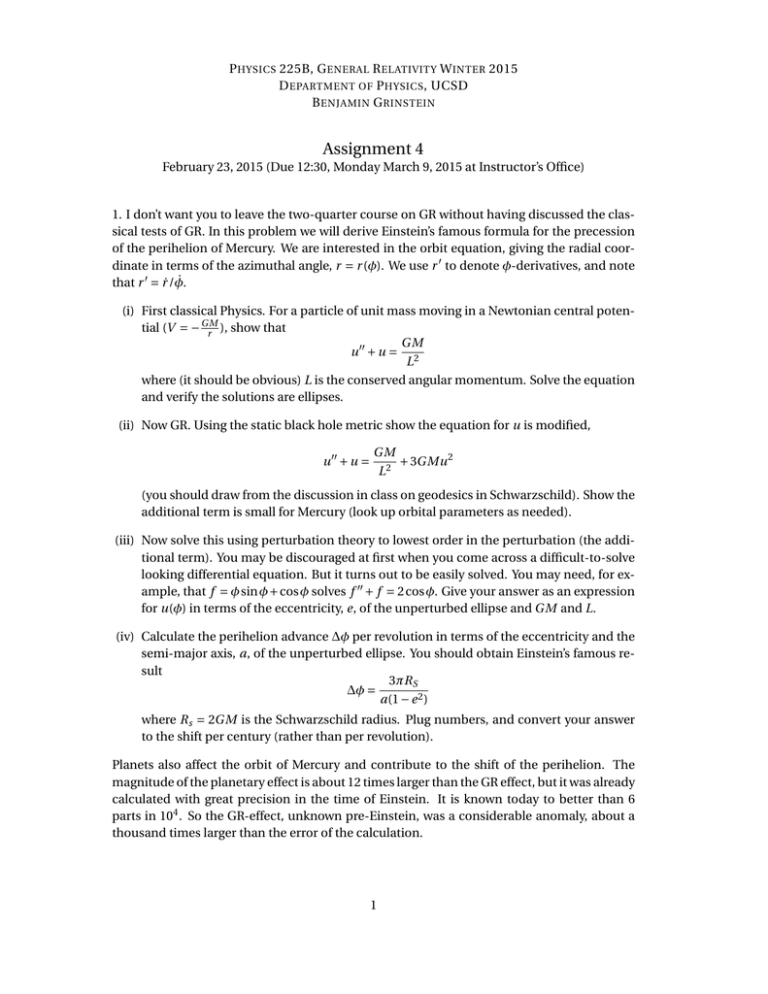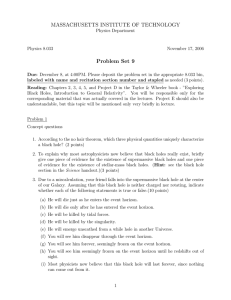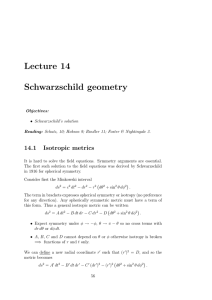Assignment 4
advertisement

P HYSICS 225B, G ENERAL R ELATIVITY W INTER 2015 D EPARTMENT OF P HYSICS , UCSD B ENJAMIN G RINSTEIN Assignment 4 February 23, 2015 (Due 12:30, Monday March 9, 2015 at Instructor’s Office) 1. I don’t want you to leave the two-quarter course on GR without having discussed the classical tests of GR. In this problem we will derive Einstein’s famous formula for the precession of the perihelion of Mercury. We are interested in the orbit equation, giving the radial coordinate in terms of the azimuthal angle, r = r (φ). We use r 0 to denote φ-derivatives, and note that r 0 = r˙/φ̇. (i) First classical Physics. For a particle of unit mass moving in a Newtonian central potential (V = − GrM ), show that GM u 00 + u = 2 L where (it should be obvious) L is the conserved angular momentum. Solve the equation and verify the solutions are ellipses. (ii) Now GR. Using the static black hole metric show the equation for u is modified, u 00 + u = GM + 3G Mu 2 L2 (you should draw from the discussion in class on geodesics in Schwarzschild). Show the additional term is small for Mercury (look up orbital parameters as needed). (iii) Now solve this using perturbation theory to lowest order in the perturbation (the additional term). You may be discouraged at first when you come across a difficult-to-solve looking differential equation. But it turns out to be easily solved. You may need, for example, that f = φ sin φ + cos φ solves f 00 + f = 2 cos φ. Give your answer as an expression for u(φ) in terms of the eccentricity, e, of the unperturbed ellipse and G M and L. (iv) Calculate the perihelion advance ∆φ per revolution in terms of the eccentricity and the semi-major axis, a, of the unperturbed ellipse. You should obtain Einstein’s famous result 3πR S ∆φ = a(1 − e 2 ) where R s = 2G M is the Schwarzschild radius. Plug numbers, and convert your answer to the shift per century (rather than per revolution). Planets also affect the orbit of Mercury and contribute to the shift of the perihelion. The magnitude of the planetary effect is about 12 times larger than the GR effect, but it was already calculated with great precision in the time of Einstein. It is known today to better than 6 parts in 104 . So the GR-effect, unknown pre-Einstein, was a considerable anomaly, about a thousand times larger than the error of the calculation. 1 You cannot get this problem wrong: it is a subject covered in detail in every textbook on GR. This is my way of forcing you to read . . . 2. Another classic test of GR (the one that made Einstein famous in the eyes of the general public) is the gravitational deflection of light. This was tested by seeing stars that were known to be blocked by the Sun. That is, stars for which the straight line between them and the Earth go through the Sun can be seen because the light does not travel in a straight line, but rather it curves around the Sun. Of course, the Sun emits a lot of light so to do this test astronomers (A. Eddington, see http://en.wikipedia.org/wiki/Arthur_Eddington) had to make observations during a total Solar eclipse. Calculate the total angle by which the Sun deflects a ray of light. Express your answer in terms of the impact parameter or of the distance of closest approach. Make reasonable, physical approximations (given that light cannot go through the Sun’s atmosphere). What is the maximum deflection possible? 3. In class we presented how one “derives” the Schwarzschild metric from the conditions that the metric (i) have spherical symmetry, (ii) be static, and (iii) solve the empty space Einstein’s equations. In case you are fuzzy about this, this is Birkhoff’s theorem. (i) Find the metric that solves Einstein’s equations with a cosmological constant (Λ) term assuming the metric is spherically symmetric and static. By considering the Λ → 0 limit identify the “mass” M of the black hole. (ii) Show that as M → 0 the metric is a static version of dS or AdS (depending on the sign of Λ). Verify that there is a Killing horizon for the dS case and locate its radial coordinate, r Λ . What happens in the AdS case? (iii) For the dS case, consider the all-plus (Euclidean) version of the metric, by replacing t → i τ. Make a change of coordinates to one that is regular at the horizon and (perhaps by expansion linearly about r Λ ) show it is regular at the horizon provided τ is taken to be a periodic variable. The replacement t → i τ with τ periodic is precisely what is done in QFT to go from vacuum Green functions to thermal Green functions. 4. Consider an observer orbiting (free-falling) a Riessner-Nordstrom black hole of charge Q and mass M . His orbit is a circle of circumference C . Does the observer experience a magnetic field? If so, what is it? 2






